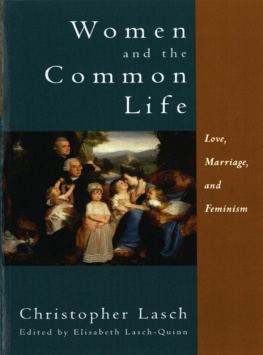Black Neighbors
1993 The University of North Carolina Press
All rights reserved
Manufactured in the United States of America
Library of Congress Cataloging-in-Publication Data
Lasch-Quinn, Elisabeth.
Black neighbors : race and the limits of reform in the American
settlement house movement, 1890-1945 / by Elisabeth Lasch-Quinn.
p. cm.
Revision of thesis (doctoral).
Includes bibliographical references (p. ) and index.
isbn 0-8078-2114-4 (cloth : alk. paper).isbn 0-8078-4423-3
(pbk. : alk. paper)
1. Social settlementsUnited StatesHistory. 2. Social work with Afro-AmericansUnited StatesHistory. 3. United StatesRace relations. I. Title.
HV4194.L37 1993
362.5570973dc20 93-18533
CIP
The paper in this book meets the guidelines for permanence and durability of the Committee on Production Guidelines for Book Longevity of the Council on Library Resources.
97 96 95 94 93 5 4 3 2 1
THIS BOOK WAS DIGITALLY MANUFACTURED.
To Ray and my parents
When [the soul] breathes
through his intellect, it
is genius; when it breathes
through his will, it is virtue;
when it flows through his
affection, it is love.
Ralph Waldo Emerson,
The Over-Soul
Contents
Illustrations
Acknowledgments
My gratitude goes to all those who inspired, encouraged, and assisted me in this endeavor. Bruce Laurie and Paula Baker did all this and more. Together with Jean Bethke Elshtain, Constance McGovern, and John Bracey, they provided helpful insights for revising the original manuscript of this book. I deeply appreciate the early and persistent interest of Lewis Bateman and the University of North Carolina Press as well as all the subsequent work involved in bringing the book to publication. Jacquelyn Dowd Hall and an anonymous reader for the University of North Carolina Press provided invaluable suggestions and encouragement. Ralph Luker, Judith Trolander, and Allen Davis gave heartening responses to parts of this work. In addition, I am deeply indebted to the interest and confidence of my colleagues and students at Syracuse University, with whom it has been my great pleasure to work. I am delighted to have found several true birds of a feather.
I am very thankful for the financial resources at my disposal. The University of Massachusetts and the department of history provided two University fellowships. The Henry J. Kaiser Research Travel Grant of the Archives of Labor and Urban Affairs of the Walter Reuther Library at Wayne State University and the Center for the Study of Philanthropy Research Grant helped defray the costs of research travel. Syracuse University provided funds for additional research through the Appleby-Mosher Fund and the Small Grants Program.
I have fond memories from the numerous trips to and long-distance communications with archives that this project entailed. The staffs at the Urban Archives Center at Temple University, Hampton University Archives, the Social Welfare History Archives at the University of Minnesota, the Sophia Smith Collection at Smith College, the Black Women Oral History Project at Radcliffe College, the University of Massachusetts Microfilm Room, the Civil Rights Documentation Project at Howard University, the Archives of Labor and Urban Affairs of the Walter Reuther Library at Wayne State University, Southern Oral History Collection, Archives of Industrial Society at the University of Pittsburgh, and others gave vital assistance. Fritz Malval of Hampton, David Klaassen of the Social Welfare History Archives, John Grabowski of Case Western Reserve Historical Society, and Michael Breedlove of the State of Alabama Department of Archives and History at Montgomery showed particular interest in the project.
Friends and relatives have made life during the production of this vast project worthwhile, pleasurable, and possible. Linda Pitelka, Lori Kran, my sister Kate Ramdin, and my grandfather, Henry Steele Commager, offered much early encouragement. And as always, I found I could rely on my brother, Chris Lasch, for help, interest, and friendship.
My parents, Nell and Christopher Lasch, deserve the highest praise and thanks for their unbounded love and support. This book owes its existence to theirs. My father's encouragement and example were, and always will be, wellsprings of inspiration.
Finally, I cannot imagine accomplishing this without the infinite, daily efforts of my husband, Raymond Lasch-Quinn. The vastness of his love and generosity defies words.
Black Neighbors
Introduction
In 1911, prominent Progressive Era reformer Jane Addams remarked that, everywhere in America, a strong race antagonism is asserting itself. The settlement house movement grew out of an awareness of the severe conditions facing newcomers to the city. While it attempted to address the needs of white immigrants, it largely ignored the parallel situation of African Americans when they began to replace whites in settlement neighborhoods.
The first half of this study seeks to explain the tragic failure of the mainstream settlement house movement to redirect its energies toward its black neighbors. The second half aims to show how other institutions, which neither practitioners nor examiners of settlement work have traditionally considered part of the settlement movement, did conduct a version of settlement work in black communities. This history, however, articulates an expanded definition of settlement work that embraces those efforts among blacks incorporating the settlement movement's dual commitment to provide a vast array of social service, educational, and recreational programs, and to usher in sweeping social change. Expanding the regional scope beyond the northern and midwestern metropolis and the temporal reach beyond the Progressive Era predicates such an encompassing notion. Following the unfolding of the settlement movement in new eras and overlooked regions establishes important links among institutions formerly deemed inherently different. An expanded definition, geographical scope, and periodization of settlement work begins to shed light on the enigmatic role of race in American reform. This introduction will briefly present a review of the essence of the settlement house, a sketch of the main scholarly schools of thought on the settlement movement, an elaboration of the general thesis, structure, and purpose of the current work, and an outline of the specific aims of each chapter.
The settlement house, a community center staffed by volunteers, was a leading philanthropic institution in the United States, modeled after the example of Toynbee Hall in London. It sought to help the poor, usually European immigrants, adjust to the industrial city. Settlement workers actually resided in run-down areas of the city, encountering poverty firsthand and translating their experiences into concrete social reforms. Settlement work thus symbolized a unique marriage of direct delivery of social services and commitment to sweeping social change.
The settlement house also offered a remarkable range of activities that integrated social welfare services, vocational training, liberal education, cultural programs, recreation, and entertainment. The premises themselves served as everything from employment bureau to day-care center, public bath to night school, gymnasium to union hall, and soup kitchen to salon. Immigrants and migrant blacks who found the metropolis confusing and even dangerous often turned for assistance to their own kin networks, churches, families, and societies. While these groups fostered a sense of community, the settlement house attempted to offer the additional asset of bridging the gap between the foreign colony and the established institutions in the rest of the city. Settlement workers, mostly college-educated middle-class women, sought to make use of their privileged backgrounds to provide access to power and resources otherwise denied to workers or the poor. These early social workers managed to convey useful information and skills that could help their neighbors make their way in and eventually out of the city.






